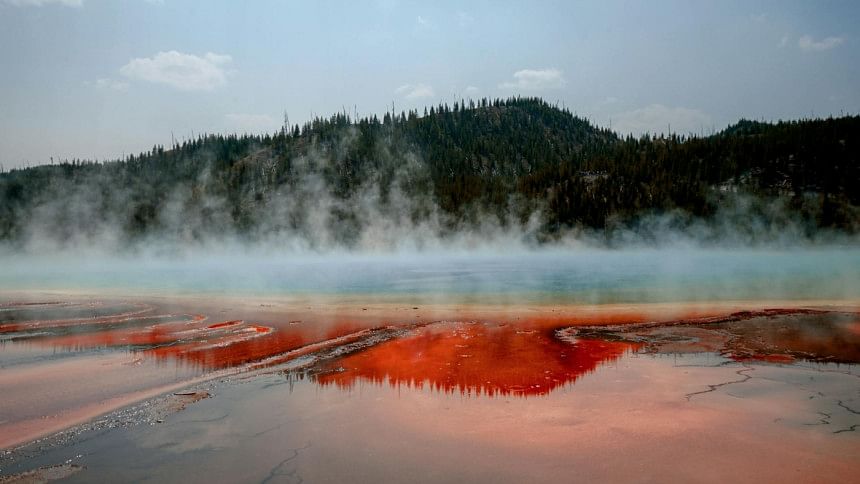Carbon sinks in crisis: Explained

Growing up, I was told not to pick leaves from plants, especially at night. At the time, I was told plants sleep at night and it hurts them when we pick leaves. I never quite questioned it further. Little did I know as the sun goes down, the entire forest wakes up with trees, plants, and fungi engaging in a quiet daily exchange.
Through photosynthesis, these organisms pull carbon dioxide from the air and convert it to the energy they need. While we sleep, the plants continue to inhale carbon dioxide, and other organisms tend to store vast amounts of it. This is just one of the many efficient systems working to protect the equilibrium in the atmosphere. One of these systems is the Earth's natural carbon sink which collects nearly half of the carbon dioxide released in the atmosphere by humans.
A carbon sink is anything that absorbs more carbon from the atmosphere than it releases. On the other hand, a carbon source is anything that releases more carbon in the atmosphere than it absorbs.
Carbon is present everywhere – in our food, in the air we breathe, in our DNAs. The amount of carbon on earth has never quite changed but the places where it is stored has. Most carbon is storied in sinks, such as rocks and sediments. The remainder is stored in the atmosphere, oceans, and living organisms. Respiration by animals and plants releases the carbon back into the atmosphere. This process of storing and releasing is known as the carbon cycle.
This process has remained in balance for thousands of years on Earth. But now scientists are anxious over this cycle breaking up resulting in 2023 being recorded as the hottest year in the 174-year observational record, according to World Meteorological Organisation (WMO). Terrestrial sinks only absorbed between 1.5 and 2.6 billion metric tons of carbon dioxide in 2023, which is only a quarter to a third of the usual.
This breakdown of land carbon sink could be temporary if there is no additional pressure of droughts or wildfires. Unfortunately, that is not the case. While land carbon sinks may return to absorbing carbon again, there are indications of the fragility of the ecosystem. These discrepancies are only limited to land carbon sinks but also includes the ocean which are showing major instability in their system.
Carbon is stored in the ocean's depth both in dissolved form and as part of marine sediments. With the rising temperature, the oceans are losing their ability to absorb carbon dioxide because warmer water tends to absorb less of it.
Moreover, Greenland glaciers and Arctic ice sheets are melting faster than expected. An increased melting rate is also disrupting the Gulf Stream current –slowing down the rate at which oceans absorb carbon. Melting ice is also exposing the algae-eating zooplankton to the sun for an extended period. Scientists say that this change could keep the zooplankton in depth for longer leading to disruption of the storage of carbon on the ocean floor.
Human activities, such as the burning of fossil fuels and deforestation, release significant amounts of carbon dioxide into the atmosphere – disrupting the natural carbon cycle. In 2023, carbon pollution – as a result of human activity – reached a record 37.4 billion tonnes. With such record-breaking carbon emissions, it is getting harder for them to absorb atmospheric carbon. While it may be possible to remove carbon on a large scale with the aid of technology, reaching net zero is not feasible with it alone.
Despite the challenges, there is growing interest in artificial carbon sinks. Artificial carbon sinks use technology to capture carbon dioxide directly from the atmosphere and store or repurpose it. This approach, known as Carbon Capture, Utilisation, and Storage (CCUS), is becoming increasingly important.
One such technology is Direct Air Capture (DAC). DAC systems use large fans to pull air from the atmosphere, passing it through chemical filters that extract carbon dioxide. This captured carbon dioxide can then be utilised or stored in several ways. While artificial carbon sinks provide a new way to capture and store carbon, the use of CCUS technology has faced many challenges, making it hard to adopt and scale these systems.
In the period that we have observed the earth's climate, it has existed in a fragile equilibrium. But this balance has been disrupted driven primarily by rising temperatures. With the ecosystem already under strain, there remains only one strong carbon sink in the Congo basin. Yet we are lulled into a comfort zone relying on nature to do its work. But can we really ignore the crisis?
The weakening of land sinks, though regional, is already undermining nations' efforts on decarbonisation and climate goals. Natural carbon sinks have been taken for granted in political and governmental spheres, despite uncertainty about their long-term reliability. While some propose increasing carbon absorption through forests and ecosystems, researchers emphasise that the priority should be protecting existing carbon sinks by stopping deforestation, reducing emissions, and maintaining their health.
Adrin Sarwar is a student of Printing and Publication Studies. Send her inspirations to [email protected]
Reference
The Guardian (October 14, 2024). Trees and land absorbed almost no CO2 last year. Is nature's carbon sink failing?.
Greenly (July 26, 2024). What is a Carbon Sink?.
IEA (2024). Executive Summary – CO2 Emissions in 2023 – Analysis.
Le Monde.fr (July 30, 2024). Land carbon sinks collapsed in 2023, a stark warning of climate changes to come.

 For all latest news, follow The Daily Star's Google News channel.
For all latest news, follow The Daily Star's Google News channel. 








Comments